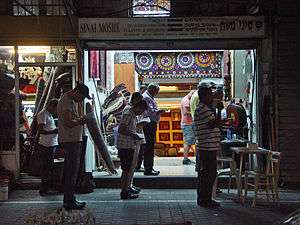Jewish prayer
Jewish prayer (Hebrew: תְּפִלָּה, tefillah [tfiˈla]; plural תְּפִלּוֹת tefillot [tfiˈlot]; Yiddish: תּפֿלה, romanized: tfile [ˈtfɪlə], plural תּפֿלות tfilles [ˈtfɪləs]; Yinglish: davening /ˈdɑːvənɪŋ/ from Yiddish דאַוון davn 'pray') is the prayer recitation that forms part of the observance of Rabbinic Judaism. These prayers, often with instructions and commentary, are found in the siddur, the traditional Jewish prayer book.
| Part of a series on |
| Judaism |
|---|
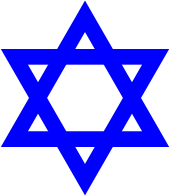   |
|
|
|
|
|
Other religions |
|
Related topics |
|
.jpg)

Prayer—as a "service of the heart"—is in principle a Torah-based commandment.[1] It is not time-dependent and is mandatory for both Jewish men and women.[2] However, the rabbinic requirement to recite a specific prayer text does differentiate between men and women: Jewish men are obligated to recite three prayers each day within specific time ranges (zmanim), while, according to many approachs, women are only required to pray once or twice a day, and many not be required to recite a specific text.[3]
Traditionally, three prayer services are recited daily:
- Morning prayer: Shacharit or Shaharit (שַחֲרִית, "of the dawn")
- Afternoon prayer: Mincha or Minha (מִנְחָה), named for the flour offering that accompanied sacrifices at the Temple in Jerusalem,
- Evening prayer:[4] Arvit (עַרְבִית, "of the evening") or Maariv (מַעֲרִיב, "bringing on night")
Two additional services are recited on Shabbat and holidays:
- Musaf (מוּסָף, "additional") are recited by Orthodox and Conservative congregations on Shabbat, major Jewish holidays (including Chol HaMoed), and Rosh Chodesh.
- Ne'ila (נְעִילָה, "closing"), is recited only on Yom Kippur.
A distinction is made between individual prayer and communal prayer, which requires a quorum known as a minyan, with communal prayer being preferable as it permits the inclusion of prayers that otherwise would be omitted.
Prayers recorded in the Bible are personal compositions rather than a standard text. According to tradition, many of the current standard prayers were composed by the sages of the Great Assembly in the early Second Temple period (516 BCE – 70 CE). The language of the prayers, while clearly from this period, often employs Biblical idiom. The main structure of the modern prayer service was fixed in the tannaic era (1st-2nd centuries CE), with some additions and the exact text of blessings coming later. Jewish prayerbooks emerged during the early Middle Ages during the period of the Geonim of Babylonia (6th–11th centuries CE).[5]
Over the last 2000 years, traditional variations have emerged among the traditional liturgical customs of different Jewish communities, such as Ashkenazic, Sephardic, Yemenite, Eretz Yisrael and others, or rather recent liturgical inventions such as Hassidic, and Chabad. However the differences are minor compared with the commonalities. Most of the Jewish liturgy is sung or chanted with traditional melodies or trope. Synagogues may designate or employ a professional or lay hazzan (cantor) for the purpose of leading the congregation in prayer, especially on Shabbat or holidays.
Origin and history of Jewish prayer
Biblical origin
According to the Babylonian Talmud, prayer is a Biblical command:
- 'You shall serve God with your whole heart' (Deut 11:13) - What service is performed with the heart? This is prayer.[6]
Based on this passage, Maimonides categorizes daily prayer as one of the 613 commandments.[7] He rules that the commandment is fulfilled by any prayer at any time in the day, not a specific text; and thus is not time-dependent, and is mandatory for both Jewish men and women.[2] In contrast, the requirement to say specific prayers at specific times is based not on Biblical law, but rather rabbinic decree.[8]
The number of prayers per day
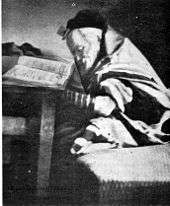
Additional references in the Hebrew Bible have been interpreted to suggest that King David and the prophet Daniel prayed three times a day. In Psalms, David states:
And in the Book of Daniel:
- And Daniel, when he knew that a writ had been inscribed, came to his house, where there were open windows in his upper chamber, opposite Jerusalem, and three times a day he kneeled on his knees and prayed and offered thanks before his God just as he had done prior to this.[10]
The Talmud gives two reasons why there are three basic prayers each day:[11]
- Each service was instituted parallel to a sacrificial act in the Temple in Jerusalem: the morning Tamid offering, the afternoon Tamid offering, and the overnight burning of this last offering.
- According to Rabbi Jose bar Hanina, each of the Patriarchs instituted one prayer: Abraham the morning, Isaac the afternoon and Jacob the evening prayers. This view is supported with Biblical quotes indicating that the Patriarchs prayed at the times mentioned. However, even according to this view, the exact times of when the services are held, and moreover the entire concept of a mussaf service, are still based on the sacrifices.
Development of the prayer text
The earliest parts of Jewish prayer are the Shema Yisrael (Deuteronomy 6:4-9, 11:13-21, Numbers 15:37-41), and the Priestly Blessing (Numbers 6:24–26), which are in the Torah.
Maimonides asserts that until the Babylonian exile, all Jews composed their own prayers. After the exile, however, when the exiles' understanding of Hebrew diminished and they found it difficult to compose prayers in Hebrew, Ezra and his court composed the Amidah prayer.[8] Modern scholarship dating from the Wissenschaft des Judentums movement of 19th-century Germany, as well as textual analysis influenced by the 20th-century discovery of the Dead Sea Scrolls, suggests that dating from the Second Temple period there existed "liturgical formulations of a communal nature designated for particular occasions and conducted in a centre totally independent of Jerusalem and the Temple, making use of terminology and theological concepts that were later to become dominant in Jewish and, in some cases, Christian prayer."[12]
The structure of the modern Jewish prayer service was established during the period of the Tannaim, "from their traditions, later committed to writing, we learn that the generation of rabbis active at the time of the destruction of the Second Temple (70 CE) gave Jewish prayer its structure and, in outline form at least, its contents."[13] This liturgy included the twice-daily recitation of the Shema, the Amidah, and the cycle of public Torah reading.[13]
The Amidah (or Shemoneh Esreh) prayer is traditionally ascribed to the Great Assembly (in the time of Ezra, near the end of the Biblical period), though other sources suggest it was established by Simeon HaPakoli in the late 1st century. Even in the 1st century, though, the precise wording of the blessings was not yet fixed, and varied from locale to locale. By the Middle Ages the texts of the blessings was nearly fixed, and in the form in which they are still used today.
Readings from the Torah (five books of Moses) and the Nevi'im ("Prophets") are specified in the Mishnah and Talmud, as are the order of blessings surrounding the Shema. Other parts of the service, such as Pesukei dezimra, have little mention in early sources, but became established by custom.
The oldest prayer books date from the time of the Geonim of Babylonia; "some were composed by respected rabbinic scholars at the request of far-flung communities seeking an authoritative text of the required prayers for daily use, Shabbat, and holidays."[13] The earliest existing codification of the prayerbook was drawn up by Rav Amram Gaon of Sura, Babylon, about 850 CE. Half a century later Rav Saadia Gaon, also of Sura, composed a siddur, in which the rubrical matter is in Arabic. These were the basis of Simcha ben Samuel's Machzor Vitry (11th-century France), which was based on the ideas of his teacher, Rashi. Another formulation of the prayers was that appended by Maimonides to the laws of prayer in his Mishneh Torah: this forms the basis of the Yemenite liturgy, and has had some influence on other rites. From this point forward, all Jewish prayerbooks had the same basic order and contents.
The siddur was printed by Soncino in Italy as early as 1486, though a siddur was first mass-distributed only in 1865. The siddur began appearing in the vernacular as early as 1538. The first English translation, by Gamaliel ben Pedahzur (a pseudonym), appeared in London in 1738; a different translation was released in the United States in 1837.[14]
Over the last 2000, the various branches of Judaism have resulted in small variations in the Rabbinic liturgy customs among different Jewish communities, with each community having a slightly different nusach (customary liturgy). The principal difference is between Ashkenazic and Sephardic customs, although there are other communities (e.g., Yemenite and Italian Jews, and in the past Eretz Yisrael), and rather recent liturgical inventions such as Hassidic, Chabad, Reform and other communities also have distinct customs, variations, and special prayers. However, the differences between all these customs are quite minor compared with the commonalities.
Text and language
According to halakha, all individual prayers and virtually all communal prayers may be said in any language that the person praying understands. For example, the Mishnah mentions that the Shema need not be said in Hebrew.[15] A list of prayers that must be said in Hebrew is given in the Mishna,[16] and among these only the Priestly Blessing is in use today, as the others are prayers that are to be said only in a Temple in Jerusalem, by a priest, or by a reigning King.
Despite this, the tradition of most Ashkenazi Orthodox synagogues is to use Hebrew for all except a small number of prayers, including Kaddish and Yekum Purkan in Aramaic, and Gott Fun Avraham, which was written in Yiddish. In other streams of Judaism there is considerable variability: Sephardic communities may use Ladino or Portuguese for many prayers; Conservative synagogues tend to use the local language to a varying degree; and at some Reform synagogues almost the whole service may be in the local language.
The language of the prayers, while clearly being from the Second Temple period,[17] often employs Biblical idiom, and according to some authorities it should not contain rabbinic or Mishnaic idiom apart from in the sections of Mishnah that are featured.
Denominational variations
Conservative services generally use the same basic format for services as in Orthodox Judaism, with some doctrinal leniencies and some prayers in English. In practice, there is wide variation among Conservative congregations. In traditionalist congregations the liturgy can be almost identical to that of Orthodox Judaism, almost entirely in Hebrew (and Aramaic), with a few minor exceptions, including excision of a study session on Temple sacrifices, and modifications of prayers for the restoration of the sacrificial system. In more liberal Conservative synagogues there are greater changes to the service, with up to a third of the service in English; abbreviation or omission of many of the preparatory prayers; and replacement of some traditional prayers with more contemporary forms. There are some changes for doctrinal reasons, including egalitarian language, fewer references to restoring sacrifices in the Temple in Jerusalem, and an option to eliminate special roles for Kohanim and Levites.
The liturgies of Reform and Reconstructionist are based on traditional elements, but contains language more reflective of liberal belief than the traditional liturgy. Doctrinal revisions generally include revising or omitting references to traditional doctrines such as bodily resurrection, a personal Jewish Messiah, and other elements of traditional Jewish eschatology, Divine revelation of the Torah at Mount Sinai, angels, conceptions of reward and punishment, and other personal miraculous and supernatural elements. Services are often from 40% to 90% in the vernacular.
Reform Judaism has made greater alterations to the traditional service in accord with its more liberal theology including dropping references to traditional elements of Jewish eschatology such as a personal Messiah, a bodily resurrection of the dead, and others. The Hebrew portion of the service is substantially abbreviated and modernized and modern prayers substituted for traditional ones. In addition, in keeping with their view that the laws of Shabbat (including a traditional prohibition on playing instruments) are inapplicable to modern circumstances, Reform services often play instrumental or recorded music with prayers on the Jewish Sabbath. All Reform synagogues are Egalitarian with respect to gender roles.
Philosophy of prayer
In Jewish philosophy and in Rabbinic literature, it is noted that the Hebrew verb for prayer—hitpallel התפלל—is in fact the reflexive form of palal פלל, to judge. Thus, "to pray" conveys the notion of "judging oneself":[18] ultimately, the purpose of prayer—tefilah תפלה—is to transform ourselves.[19][20]
This etymology is consistent with the Jewish conception of divine simplicity. It is not God that changes through our prayer—Man does not influence God as a defendant influences a human judge who has emotions and is subject to change—rather it is man himself who is changed.[21] It is further consistent with Maimonides' view on Divine Providence. Here, Tefillah is the medium which God gave to man by means of which he can change himself, and thereby establish a new relationship with God—and thus a new destiny for himself in life;[21][22] see also under Psalms.
The rationalist approach
In this view, the ultimate goal of prayer is to help train a person to focus on divinity through philosophy and intellectual contemplation. This approach was taken by Maimonides and the other medieval rationalists.
The educational approach
In this view, prayer is not a conversation. Rather, it is meant to inculcate certain attitudes in the one who prays, but not to influence. This has been the approach of Rabbenu Bachya, Yehuda Halevy, Joseph Albo, Samson Raphael Hirsch, and Joseph B. Soloveitchik. This view is expressed by Rabbi Nosson Scherman in the overview to the Artscroll Siddur (p. XIII); note that Scherman goes on to also affirm the Kabbalistic view (see below).
Kabbalistic view
Kabbalah (esoteric Jewish mysticism) uses a series of kavanot, directions of intent, to specify the path the prayer ascends in the dialogue with God, to increase its chances of being answered favorably. Kabbalism ascribes a higher meaning to the purpose of prayer, which is no less than affecting the very fabric of reality itself, restructuring and repairing the universe in a real fashion. In this view, every word of every prayer, and indeed, even every letter of every word, has a precise meaning and a precise effect. Prayers thus literally affect the mystical forces of the universe, and repair the fabric of creation.
This approach has been taken by the Chassidei Ashkenaz (German pietists of the Middle-Ages), the Zohar, the Arizal's Kabbalist tradition, the Ramchal, most of Hassidism, the Vilna Gaon and Jacob Emden.
Hassidism, although incorporating the kabbalistic worldview and its corresponding kavanot, also emphasized straightforward sincerity and depth of emotional engagement in prayer.[23] The Baal Shem Tov's great-grandson, Rebbe Nachman of Breslov, particularly emphasized speaking to God in one's own words, which he called Hitbodedut (self-seclusion) and advised setting aside an hour to do this every day (Likutei Moharan 2:25).
Methodology and terminology
Terms for praying
Daven is the originally exclusively Eastern Yiddish verb meaning "pray"; it is widely used by Ashkenazic Orthodox Jews. In Yinglish, this has become the Anglicised davening.
The origin of the word is obscure, but is thought by some to have come from Arabic (from diwan, a collection of poems or prayers), French (from devoner, 'to devote' or 'dedicate' or possibly from the French 'devant'- 'in front of' with the idea that the person praying is mindful of before whom they stand), Latin (from divin, 'divine') or even English (from dawn).[24] Others believe that it derives from a Slavic word meaning "to give" (Russian: давать, romanized: davat'). Some claim that it originates from an Aramaic word, de'avuhon or d'avinun, meaning 'of their/our forefathers', as the three prayers are said to have been invented by Abraham, Isaac and Jacob. Another Aramaic derivation, proposed by Avigdor Chaikin, cites the Talmudic phrase, "ka davai lamizrach", 'gazing wistfully to the east' (Shab. 35a). Kevin A. Brook,[25] cites Zeiden's suggestion[26] that the word daven comes from the Turkish root tabun- meaning 'to pray', and that in Kipchak Turkish, the initial t morphs into d.
In Western Yiddish, the term for pray is oren, a word with clear roots in Romance languages—compare Spanish and Portuguese orar and Latin orare.[27]
Minyan (quorum)
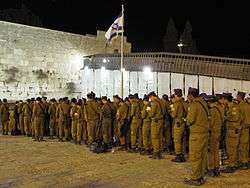
Individual prayer is considered acceptable, but prayer with a quorum of ten Jewish adults—a minyan—is the most highly recommended form of prayer and is required for some prayers. An adult in this context means over the age of 12 or 13 (bat or bar mitzvah). Judaism had originally counted only men in the minyan for formal prayer, on the basis that one does not count someone who is not obligated to participate. The rabbis had exempted women from almost all time-specific positive mitzvot (commandments), including those parts of the prayer that cannot be recited without a quorum, due to women in the past being bound up in an endless cycle of pregnancy, birthing and nursing from a very early age. Orthodox Judaism still follows this reasoning and excludes women from the minyan.
Since 1973, Conservative congregations have overwhelmingly become egalitarian and count women in the minyan. A very small number of congregations that identify themselves as Conservative have resisted these changes and continue to exclude women from the minyan. Those Reform and Reconstructionist congregations that consider a minyan mandatory for communal prayer, count both men and women for a minyan. All denominations of Judaism except for Orthodox Judaism ordain female rabbis and cantors.[28][29]
There is a publicly said prayer, called Birkhat HaGomel, for giving thanks for surviving an illness or danger.[30] which, in addition to needing a Minyan, also needs a Torah scroll taken out for a scheduled Torah reading.
Attire
- Head covering. In most synagogues, it is considered a sign of respect for male attendees to wear a head covering, either a dress hat or a kippa (skull cap, plural kipot also known by the Yiddish term yarmulke). It is common practice for both Jews and non-Jews who attend a synagogue to wear a head covering.[31][32] Some Conservative synagogues may also encourage (but rarely require) women to cover their heads. Many Reform and Progressive temples do not require people to cover their heads, although individual worshipers, both men and women, may choose to. Many Orthodox and some conservative men and women wear a head covering throughout their day, even when not attending religious services.
- Tallit (prayer shawl) is traditionally worn during all morning services, during Aliyah to the Torah, as well as during all the services of Yom Kippur. During the daily afternoon and evening services, the hazzan alone wears a tallit. In Orthodox synagogues they are expected to be worn only by men who are halakhically Jewish and though in some Conservative synagogues they should be worn only by men, in other Conservative synagogues both men and women who are halakhically Jewish should wear a tallit. In most Orthodox Ashkenazi synagogues they are worn only by men who are or have been married.[33]
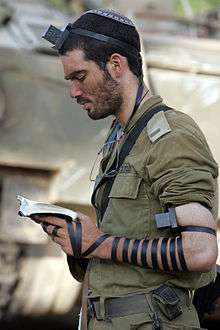
- Tefillin (phylacteries) are a set of small cubic leather boxes painted black, containing scrolls of parchment inscribed with verses from the Torah. They are tied to the head and arm with leather straps dyed black, and worn by Jews only, during weekday morning prayers. In Orthodox synagogues they are expected to be worn only by men; in Conservative synagogues they are also worn by some women. The Karaite Jews, however, do not don tefillin.
- Tzeniut (modesty) applies to men and women. When attending Orthodox synagogues, women will likely be expected to wear long sleeves (past the elbows), long skirts (past the knees), a high neckline (to the collar bone), and if married, to cover their hair with a wig, scarf, hat or a combination of the above. For men, short pants or sleeveless shirts are generally regarded as inappropriate. In some Conservative and Reform synagogues the dress code may be more lax, but still respectful.
Other laws and customs
In the event one of the prayers was missed inadvertently, the Amidah prayer is said twice in the next service—a procedure known as tefillat tashlumin.[34]
Many Jews sway their body back and forth during prayer. This practice, referred to as shuckling in Yiddish, is not mandatory.
Many are accustomed to giving charity before, during (especially during Vayivarech David) or after prayer, in the hopes that this will make their prayer more likely to be heard.
Daily prayers
Shacharit (morning prayers)
The Shacharit (from shachar, morning light) prayer is recited in the morning. Halacha limits parts of its recitation to the first three (Shema) or four (Amidah) hours of the day, where "hours" are 1/12 of daylight time, making these times dependent on the season.
Various prayers are said upon arising; the tallit katan (a garment with tzitzit) is donned at this time. The tallit (large prayer shawl) is donned before or during the actual prayer service, as are the tefillin (phylacteries); both are accompanied by blessings.
The service starts with the "morning blessings" (birkot ha-shachar), including blessings for the Torah (considered the most important ones). In Orthodox services this is followed by a series of readings from Biblical and rabbinic writings recalling the offerings made in the Temple in Jerusalem. The section concludes with the "Rabbis' Kaddish" (kaddish de-rabbanan).
The next section of morning prayers is called Pesukei dezimra ("verses of praise"), containing several psalms (100 and 145–150), and prayers (such as yehi chevod) made from a tapestry of Biblical verses, followed by Song of the Sea (Exodus 14-15).
Barechu, the formal public call to prayer, introduces a series of expanded blessings embracing the recitation of the Shema. This is followed by the core of the prayer service, the Amidah or Shemoneh Esreh, a series of 19 blessings. The next part of the service, is Tachanun, supplications, which is omitted on days with a festive character (and by Reform services usually entirely).
On Mondays and Thursdays, a longer version of Tachanun is recited, and Torah reading is done after Tachanun.
Concluding prayers (see Uva letzion) and Aleinu then follow, with the Kaddish of the mourners generally after Aleinu.
Mincha (afternoon prayers)
Mincha or Minha may be recited from half an hour after halachic noontime until sunset.
Sephardim and Italian Jews start the Mincha prayers with Psalm 84 and Korbanot (Numbers 28:1–8), and usually continue with the Pittum hakketoret. The opening section is concluded with Malachi 3:4. Western Ashkenazim recite the Korbanot only.
Ashrei is recited, followed by half-Kaddish, the Amidah (including repetition), Tachanun, and then the full Kaddish. Sephardim insert Psalm 67 or 93, followed by the Mourner's Kaddish. After this follows, in most modern rites, the Aleinu. Ashkenazim then conclude with the Mourner's Kaddish. Service leaders often wear a tallit even on normal days, and must wear one during the fast days.
Ma'ariv/Arvit (evening prayers)
In many congregations, the afternoon and evening prayers are recited back-to-back on a working day, to save people having to attend synagogue twice.[35] The Vilna Gaon discouraged this practice, and followers of his set of customs commonly wait until after nightfall to recite Ma'ariv (the name derives from the word "nightfall").[36]
This service begins with Barechu, the formal public call to prayer, and Shema Yisrael embraced by two benedictions before and two after. Ashkenazim outside of Israel (except Chabad-Lubavitch and followers of the Vilna Gaon) then add a fifth blessing, Baruch Adonai le-Olam. (This prayer is also said by Baladi Yemenite Jews in and out of Israel.) This is followed by the Half-Kaddish, and the Amidah, followed by the full Kaddish. Sephardim then say Psalm 121, say the Mourner's Kaddish, and repeat Barechu before concluding with the Aleinu. Ashkenazim, in the diaspora, neither say Psalm 121 nor repeat Barechu, but conclude with Aleinu followed by the Mourner's Kaddish (in Israel, Ashkenazim do repeat Barcheu after mourner's Kaddish).
Prayer on Shabbat
On Shabbat (the Sabbath), prayers are similar in structure to those on weekdays, although almost every part is lengthened. One exception in the Amidah, the main prayer, which is abridged. The first three and last three blessings are recited as usual, but the middle thirteen are replaced with a single blessing known as "sanctity of the day," describing the Sabbath. Atypically, this middle blessing is different for each of the prayers.
Friday night
Shabbat services begin on Friday evening with the weekday Mincha (see above), followed in some communities by the Song of Songs, and then in most communities by the Kabbalat Shabbat, the mystical prelude to Shabbat services composed by 16th-century Kabbalists. This Hebrew term literally means "Receiving the Sabbath". In many communities, the piyut Yedid Nefesh introduces the Kabbalat Shabbat prayers.
Kabbalat Shabbat is, except amongst many Italian and Spanish and Portuguese Jews, composed of six psalms, 95 to 99, and 29, representing the six week-days. Next comes the poem Lekha Dodi, based on the words of the Talmudic sage Hanina: "Come, let us go out to meet the Queen Sabbath"[37] Kabbalat Shabbat is concluded by Psalm 92 (the recital of which constitutes acceptance of the current Shabbat with all its obligations) and Psalm 93. Many add a study section here, including Bameh Madlikin and Amar rabbi El'azar and the concluding Kaddish deRabbanan and is then followed by the Maariv service; other communities delay the study session until after Maariv. Others add here a passage from the Zohar, entitled Kegavna. In modern times the Kabbalat Shabbat has been set to music by many composers including: Robert Strassburg[38] and Samuel Adler[39]
The Shema section of the Friday night service varies in some details from the weekday services—mainly in the different ending of the Hashkivenu prayer and the omission of Baruch Adonai le-Olam prayer in those traditions where this section is otherwise recited. In the Italian rite, there are also different versions of the Ma'ariv aravim prayer (beginning asher killah on Friday nights) and the Ahavat olam prayer.
Most commemorate the Shabbat at this point with VeShameru (Exodus 31:16–17). The custom to recite the biblical passage at this point has its origins in the Lurianic Kabbalah, and does not appear before the 16th century. It is therefore absent in traditions and prayer books less influenced by the Kabbalah (such as the Yemenite Baladi tradition), or those that opposed adding additional readings to the siddur based upon the Kabbalah (such as the Vilna Gaon).
On Friday night, the middle blessing of the Amidah discusses the conclusion of the Creation, quoting the relevant verses from Genesis. The Amidah is then followed by the Seven-Faceted Blessing, the hazzan's mini-repetition of the Amidah. In some Ashkenazi Orthodox synagogues the second chapter of Mishnah tractate Shabbat, Bameh Madlikin, is read at this point, instead of earlier. Kiddush is recited in the synagogue in Ashkenazi and a few Sephardi communities. The service then follows with Aleinu. Most Sephardi and many Ashkenazi synagogues end with the singing of Yigdal, a poetic adaptation of Maimonides' 13 principles of Jewish faith. Other Ashkenazi synagogues end with Adon Olam instead.
Shacharit
Shabbat morning prayers differ from weekday morning prayers in several ways: an expanded version of Pesukei dezimra, a longer version of the Yotzer ohr blessing, the seven-blessing Shabbat version of the Amidah, no Tachanun, a longer Torah reading, and some additional prayers after the Torah reading. In many communities, the rabbi (or a learned member of the congregation) delivers a sermon at the very end of Shacharit and before Mussaf, usually on the topic of the Torah reading.
Mussaf
The Musaf service starts with the silent recitation of the Amidah. The middle blessing includes the Tikanta Shabbat reading on the holiness of Shabbat, and then by a reading from the biblical Book of Numbers about the sacrifices that used to be performed in the Temple in Jerusalem. Next comes Yismechu, "They shall rejoice in Your sovereignty", and Eloheynu, "Our God and God of our Ancestors, may you be pleased with our rest" (which is recited during all Amidahs of the Sabbath. Kedushah is greatly expanded.
After the Amidah comes the full Kaddish, followed by Ein keloheinu. In Orthodox Judaism this is followed by a reading from the Talmud on the incense offering called Pittum Haketoreth and daily psalms that used to be recited in the Temple in Jerusalem. These readings are usually omitted by Conservative Jews, and are always omitted by Reform Jews.
The Musaf service culminates with the Rabbi's Kaddish, the Aleinu, and then the Mourner's Kaddish. Some synagogues conclude with the reading of Anim Zemirot, Mourner's Kaddish, the Psalm of the Day and either Adon Olam or Yigdal.
Mincha
Mincha commences with Ashrei and the prayer Uva letzion, after which the first section of the next weekly portion is read from the Torah scroll. The Amidah follows the same pattern as the other Shabbat Amidah prayers, with the middle blessing starting Attah Echad. The short prayer Tzidkatcha is recited after the Amidah, followed by Kaddish and Aleinu.
Ma'ariv
The week-day Ma'ariv is recited on the evening immediately following Shabbat, concluding with Vihi No'am, Ve-Yitten lekha, and Havdalah.
Special observances and circumstances
Rosh Hashana and Yom Kippur
| Repentance in Judaism Teshuva "Return" |
|---|
|
Repentance, atonement and higher ascent in Judaism |
| In the Hebrew Bible |
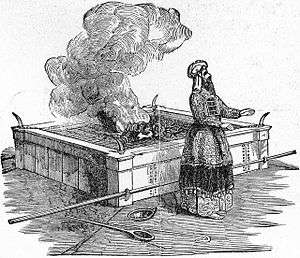 |
|
Altars · Korban Temple in Jerusalem Prophecy within the Temple |
| Aspects |
|
Confession · Atonement Love of God · Awe of God Mystical approach Ethical approach Meditation · Services Torah study Tzedakah · Mitzvot |
| In the Jewish calendar |
|
Month of Elul · Selichot Rosh Hashanah Shofar · Tashlikh Ten Days of Repentance Kapparot · Mikveh Yom Kippur Sukkot · Simchat Torah Ta'anit · Tisha B'Av Passover · The Omer Shavuot |
| In contemporary Judaism |
|
Baal Teshuva movement Jewish Renewal · Musar movement |
The services for the Days of Awe—Rosh Hashana and Yom Kippur—take on a solemn tone as befits these days. Traditional solemn tunes are used in the prayers.
The musaf service on Rosh Hashana has nine blessings; the three middle blessings include biblical verses attesting to sovereignty, remembrance and the shofar, which is sounded 100 times during the service.
Yom Kippur is the only day in the year when there are five prayer services. The evening service, containing the Ma'ariv prayer, is widely known as "Kol Nidrei", the opening declaration made preceding the prayer. During the daytime, shacharit, musaf (which is recited on Shabbat and all festivals) and mincha are followed, as the sun begins to set, by Ne'ila, which is recited just this once a year.
Pesach, Shavuot and Sukkot
The services for the three festivals of Pesach ("Passover"), Shavuot ("Feast of Weeks" or "Pentecost"), and Sukkot ("Feast of Tabernacles") are alike, except for interpolated references and readings for each individual festival. The preliminaries and conclusions of the prayers are the same as on Shabbat. The Amidah on these festivals only contains seven benedictions, with Attah Bechartanu as the main one. Hallel (communal recitation of Psalms 113-118) follows.
The Musaf service includes Umi-Penei Hata'enu, with reference to the special festival and Temple sacrifices on the occasion. A blessing on the pulpit ("dukhen") is pronounced by the "kohanim" (Jewish priests) during the Amidah. While this occurs daily in Israel and most Sephardic congregations, it occurs only on Pesach, Shavuot, Sukkot, Rosh Hashanah, and Yom Kippur in Ashkenazic congregations of the diaspora. (Those Ashkenazic congregations substitute a prayer recited by the hazzan after the Modim ("Thanksgiving") prayer) on week-days and Sabbath in commemoration of the priestly blessing.) (American Reform Jews omit the Musaf service.)
Role of women
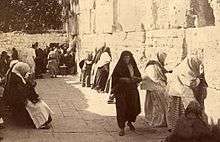
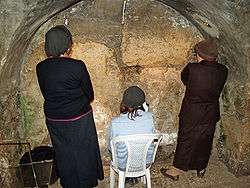
Number of obligatory prayers
According to halakha, Jewish men are obligated to perform public prayer three times a day, within specific time ranges (zmanim), plus additional services on Jewish holidays.
According to the Talmud, women are generally exempted from obligations that have to be performed at a certain time. (This has interpreted as being due to the need to constantly care for small children, or due to women's alleged higher spiritual level which makes it unnecessary for them to connect to God at specific times, since they are always connected to God.) In accordance with the general exemption from time-bound obligations, women are not required to recite the morning and evening Shema[40] (though Mishnah Berurah suggests that they say it anyway), and most Orthodox authorities have exempted women from reciting Maariv.[41]
Authorities have disagreed on whether this exemption applies to additional prayers. According to (Ashkenazi) Magen Avraham[42] and more recently (Sephardi) Rabbi Ovadia Yosef,[43] women are only required to pray once a day, in any form they choose, so long as the prayer contains praise of (brakhot), requests to (bakashot), and thanks of (hodot) God.[44] However, most Orthodox authorities agree that women are not completely exempt from time-bound prayer.[45] The Mishnah Berurah, an important code of Ashkenazic Jewish law, holds that the Men of the Great Assembly obligated women to recite Shacharit and Minchah each day, "just like men". Nonetheless, even the most liberal Orthodox authorities hold that women cannot count in a minyan for purposes of public prayer.
Traditionally, women were also reciting individual tkhine prayers in Yiddish.
Conservative Judaism regards the halakhic system of multiple daily services as mandatory. Since 2002, Jewish women from Conservative congregations have been regarded as having undertaken a communal obligation to pray the same prayers at the same times as men, with traditional communities and individual women permitted to opt out.[46] Reform and Reconstructionist congregations do not regard halakha as binding and hence regard appropriate prayer times as matters of personal spiritual decision rather than a matter of religious requirement.
Seating
Throughout Orthodox Judaism, including its most liberal forms, men and women are required to sit in separate sections with a mechitza (partition) separating them. Historically, a learned woman in the weibershul (women's section or annex) of a synagogue took on the informal role of precentress or firzogerin for the women praying in parallel to the main service led in the men's section. Conservative/Masorti Judaism permits mixed seating (almost universally in the United States, but not in all countries). All Reform and Reconstructionist congregations have mixed seating.
Prayer leaders
Haredi and the vast majority of Modern Orthodox Judaism has a blanket prohibition on women leading public congregational prayers. Conservative Judaism has developed a blanket justification for women leading all or virtually all such prayers, holding that although only obligated individuals can lead prayers and women were not traditionally obligated, Conservative Jewish women in modern times have as a collective whole voluntarily undertaken such an obligation.[47] Reform and Reconstructionist congregations permit women to perform all prayer roles because they do not regard halakha as binding.
A small liberal wing within Modern Orthodox Judaism, particularly rabbis friendly to the Jewish Orthodox Feminist Alliance (JOFA), has begun re-examining the role of women in prayers based on an individual, case-by-case look at the historical role of specific prayers and services, doing so within classical halakhic interpretation. Accepting that where obligation exists only the obligated can lead, this small group has typically made three general arguments for expanded women's roles:
- Because women were required to perform certain korbanot (sacrifices) in the Temple in Jerusalem, women today are required to perform, and hence can lead (and can count in the minyan for if required), the specific prayers substituting for these specific sacrifices. Birchat Hagomel falls in this category.
- Because certain parts of the service were added after the Talmud defined mandatory services, such prayers are equally voluntary on everyone and hence can be led by women (and no minyan is required). Pseukei D'Zimrah in the morning and Kabbalat Shabbat on Friday nights fall in this category.
- In cases where the Talmud indicates that women are generally qualified to lead certain services but do not do so because of the "dignity of the congregation", modern congregations are permitted to waive such dignity if they wish. Torah reading on Shabbat falls in this category. An argument that women are permitted to lead the services removing and replacing the Torah in the Ark on Shabbat extends from their ability to participate in Torah reading then.
A very small number of Modern Orthodox congregations accept some such arguments, but very few Orthodox congregations or authorities accept all or even most of them. Many of those who do not accept this reasoning point to kol isha, the tradition that prohibits a man from hearing a woman other than his wife or close blood relative sing. JOFA refers to congregations generally accepting such arguments as Partnership Minyanim. On Shabbat in a Partnership Minyan, women can typically lead Kabbalat Shabbat, the P'seukei D'Zimrah, the services for removing the Torah from and replacing it to the Ark, and Torah reading, as well as give a D'Var Torah or sermon.
The first Orthodox Jewish women's prayer group was created on the holiday of Simhat Torah at Lincoln Square Synagogue in Manhattan in the late 1960s.[48]
Ephraim Mirvis, an Orthodox rabbi who serves as the Chief Rabbi of the United Hebrew Congregations of the Commonwealth, supports Shabbat prayer groups for Orthodox women, saying, "Some of our congregations have women prayer groups for Friday night, some Saturday mornings. This is without women reading from the Torah. But for women to come together as a group to pray, this is a good thing."[49]
Role of minors
In most divisions of Judaism boys prior to Bar Mitzvah cannot act as a Chazzen for prayer services that contain devarim sheb'kidusha, i.e. Kaddish, Barechu, the amida, etc., or receive an aliya or chant the Torah for the congregation. Since Kabbalat Shabbat is just psalms and does not contain devarim sheb'kidusha, it is possible for a boy under Bar Mitzvah to lead until Barechu of Ma'ariv. As well, the conclusion of the service on Shabbat and Chagim may be led by children. Under the Moroccan, Yemenite, and Mizrachi customs, a boy under bar mitzvah may lead certain prayers, read the Torah, and have an aliyah.[50] It is customary among many Ashkenazim to have children sing "Adon 'Olam" after Mussaf and "Yigdal" after Shabat and Holiday Maariv. Among Sefardim, Mizrachim, Yemenites, and some Askenazim, a child leads the congregation in Kriyat Shema.
See also
References
- Notes
- Tractate Taanit 2a
- Steinsaltz, Adin (2000). A guide to Jewish prayer (1st American paperback ed.). New York: Schocken Books. pp. 26 ff. ISBN 978-0805211474. Retrieved 25 April 2016.
- Bar-Hayim, David (Rabbi, Posek). "Women and Davening: Shemone Esre, Keriyath Shem". machonshilo.org. כל הזכויות שמורות ל. Retrieved 25 April 2016.
- (editor-in-chief) Weinreb, Tzvi Hersh; (senior content editor) Berger, Shalom Z.; (managing editor) Schreier, Joshua; (commentary by) Even-Israel (Steinsaltz), Adin (2012). [Talmud Bavli] = Koren Talmud Bavli (1st Hebrew/English ed.). Jerusalem: Shefa Foundation. p. 176. ISBN 9789653015630. Retrieved 25 April 2016.CS1 maint: extra text: authors list (link)
- Center for Judaic Studies, University of Pennsylvania. "Jewish Liturgy: The Siddur and the Mahzor". Retrieved 12 March 2009.
- Ta'anit 2a
- Mishneh Torah, Laws of Prayer 1:1; Sefer Hamitzvot, positive commandment 5
- Mishneh Torah, Laws of Prayer 1:4
- Psalm 55:18
- Daniel 6:11
- Babylonian Talmud, Berachot 26b; Jerusalem Talmud, Brachot 4:1 (29b)
- Reif, Stefan C. (19–23 January 2000). "The Second Temple Period, Qumran Research and Rabbinic Liturgy: Some Contextual and Linguistic Comparisons". Fifth Orion International Symposium LITURGICAL PERSPECTIVES: PRAYER AND POETRY IN LIGHT OF THE DEAD SEA SCROLLS. The Orion Center for the Study of the Dead Sea Scrolls and Associated Literature. Retrieved 11 March 2009.
- "Overview: History of Jewish Prayer". Retrieved 12 March 2009.
- Power and Politics: Prayer books and resurrection | Jerusalem Post Archived 8 January 2012 at the Wayback Machine
- Berakhot 2:3
- Sotah 7:2
- ″Some explain that this means that prayers were instituted (..) after the destruction of the Temple to replace the offerings. However, these prayers were already extant throughout the Second Temple era with virtually the same formula that was instituted later, with certain known differences. Furthermore, there were already synagogues at that time, some even in close proximity to the Temple. There is a dispute in the Talmud about whether the prayers were instituted to parallel the offerings, or whether they have an independent source, unrelated to the Temple service.″ (editor-in-chief) Weinreb, Tzvi Hersh; (senior content editor) Berger, Shalom Z.; (managing editor) Schreier, Joshua; (commentary by) Even-Israel (Steinsaltz), Adin (2012). [Talmud Bavli] = Koren Talmud Bavli (1st Hebrew/English ed.). Jerusalem: Shefa Foundation. pp. 175 ff. ISBN 9789653015630. Retrieved 25 April 2016.CS1 maint: extra text: authors list (link)
- This interpretation is homiletic rather than scholarly, as it is historically more likely that the root meaning of hitpallel is "to seek judgement for oneself", in other words to present a legal pleading.
- "Archived copy". Archived from the original on 23 July 2008. Retrieved 23 June 2008.CS1 maint: archived copy as title (link)
- "The Cosmology of the Mitzvot".
- "Prayer".
- "Archived copy". Archived from the original on 19 October 2008. Retrieved 6 October 2008.CS1 maint: archived copy as title (link)
- Green, Arthur et al, Speaking Torah: Spiritual Teachings From Around the Maggid's Table, Jewish Lights, 2013, p.13.
- Rabbi Dr Raymond Apple. "OzTorah – Where does "Daven" come from – Ask the Rabbi". Retrieved 20 May 2013.
- The Jews of Khazaria, 2nd ed. Rowman & Littlefield 2006, p. 206
- Herbert Zeiden, "Davenen: a Turkic Etymology", Yiddish 10, nos. 2–3 (1996), pp. 96–97
- David Curwin. "Balashon – Hebrew Language Detective: daven". Retrieved 9 December 2007.
- Jewish Women's Archive. Cantors: American Jewish Women. Retrieved 2015-05-07.
- Jewish Virtual Archive. A History of Women's Ordination as Rabbis. Retrieved 2015-05-07.
- "Laws of the Blessing of Thanksgiving".
- International Council of Christians and Jews, Jewish-Christian Relations :: A glossary of terms used in the Christian-Jewish dialogue, "Non-Jewish male visitors to the synagogue are offered skull caps at the entrance and are asked to wear them."
- Rabbi Amy R. Scheinerman, What's What?, "Non-Jews who are guests in a synagogue can cover their heads; it is a sign of respect and not at all inappropriate for people who are not Jewish."
-
- Mordechai Becher, Gateway to Judaism: The What, How, And Why of Jewish Life, Mesorah Publications, 2005, p. 328.
- Joyce Eisenberg, Ellen Scolnic, Dictionary of Jewish Words, Jewish Publication Society, 2006, p. 166.
- Brachot 26a
- In strict law, one should only recite Mincha between sunset and nightfall if one recites Arvit after nightfall; conversely one should only recite Arvit between sunset and nightfall if one recites Mincha before sunset; in other words one should not take advantage of both flexibilities at once so as to combine the prayers. The prevailing practice, of doing exactly that, is regarded as an emergency measure. On yet another view, the disputed period is not that between sunset and nightfall but the last seasonally adjusted hour and a quarter before sunset.
- One reason for this is that, while the prevailing practice may satisfy the law concerning the timing of Arvit in the sense of the evening Amidah, it means that the evening Shema is recited too early.
- Shabbat 119a
- "Strassburg, Robert".
- L'kha Dodi and Samuel Adler on the milkenarchive.org
- Mishna, Berakhot 3:3.
- Mishna Berurah, Laws of Evening Prayers
- Magen Avraham, on Shulkhan Arukh section Orach Chayim, 106:2
- Yabiah Omer vol. 6, 17
- Women's Issues:Women And Prayer When Time is Short Archived 12 October 2008 at the Wayback Machine, Nishmat
- For example: the 19th-century posek Yechiel Michel Epstein, author of the Arukh HaShulkhan, notes: "Even though the rabbis set prayer at fixed times in fixed language, it was not their intention to issue a leniency and exempt women from this ritual act".
- Rabbi David Fine, Women and the Minyan, Rabbinical Assembly, 2002. Archived 27 November 2010 at the Wayback Machine
- Archived 27 November 2010 at the Wayback Machine
- "Women's Tefillah Movement – Jewish Women's Archive".
- http://www.thejc.com/news/uk-news/122918/interview-rabbi-ephraim-mirvis
- Epstein, Morris. All About Jewish Holidays and Customs. Ktav Publishing House, 1959. p. 89
- Bibliography
- To Pray As a Jew, Hayim Halevy Donin, Basic Books (ISBN 0-465-08633-0)
- Entering Jewish Prayer, Reuven Hammer (ISBN 0-8052-1022-9)
- Kavvana: Directing the Heart in Jewish Prayer, Seth Kadish, Jason Aronson Inc. 1997. ISBN 0-7657-5952-7.
- Or Hadash: A Commentary on Siddur Sim Shalom for Shabbat and Festivals, Reuven Hammer, The Rabbinical Assembly and the United Synagogue of Conservative Judaism
- S. Baer. Siddur Avodath Yisrael (newly researched text with commentary Yachin Lashon), 19th century.
- A Guide to Jewish Prayer, Rabbi Adin Steinsaltz, Shocken Books (ISBN 0-8052-4174-4)
- Hilchot Tefilla: A Comprehensive Guide to the Laws of Daily Prayer, David Brofsky, KTAV Publishing House/OU Press/Yeshivat Har Etzion. 2010. (ISBN 978-1-60280-164-6)
- God's Favorite Prayers, Tzvee Zahavy, Talmudic Books. 2011. (ISBN 978-0-615-50949-5)
- Holistic Prayer: A Guide to Jewish Spirituality, Rabbi Avi Weiss, Maggid Books. 2014. (ISBN 978-1-592-64334-9)
External links
![]()
- Jewish liturgy – Jewish Virtual Library
- Jewish Prayer – Prayer in Judaism – Chabad.org
- The Open Siddur Project
- Outline of prayer services – Jewfaq.org
- GoDaven.com – The Worldwide Minyan Database – GoDaven.com
- Introduction to Jewish Prayer – Aish.com
- Siddur in PDF
- Audio and text of the Siddur – SiddurAudio.com
- Q&A about Prayer – Ask the Rabbi
